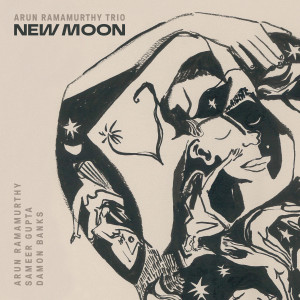 Arun Ramamurthy Trio’s debut Jazz Carnatica was one of my favorite releases of 2014 (indeed, of the entire decade of the Teens), and I’m delighted to report that their follow-up, although a decade in the making, is even better. Their sophomore release New Moon brings a similar program of Indian classical music as interpreted in the context of a jazz trio, with the added maturity in violinist Ramamurthy’s composition and leadership, and the seamless interplay among the three musicians that comes with a decade of performance.
Arun Ramamurthy Trio’s debut Jazz Carnatica was one of my favorite releases of 2014 (indeed, of the entire decade of the Teens), and I’m delighted to report that their follow-up, although a decade in the making, is even better. Their sophomore release New Moon brings a similar program of Indian classical music as interpreted in the context of a jazz trio, with the added maturity in violinist Ramamurthy’s composition and leadership, and the seamless interplay among the three musicians that comes with a decade of performance.
The trio this time out includes drummer Sameer Gupta from the debut record and Damon Banks on electric bass. (In the liner notes, Ramamurthy includes a tribute to founding acoustic bassist Perry Wortman “for starting this journey with me, and shaping the trio with your beautiful sound.”)
New Moon is bookended by contrasting tracks, opening with a highly contemporary Ramamurthy composition and closing with the trio’s exploration of a traditional raga. Banks and his electric bass announce themselves immediately with a solo introduction to “Walk As One,” which Ramamurthy says was inspired by the marches in New York’s streets following the police killing of George Floyd in Minneapolis in 2020. Banks also plays a pivotal role in the closer “Sri Valli,” an interpretation of the Carnatic song “Sri Valli Devasenapathe” by composer Papanaasam Shivan, in which the trio explores the raga Natabhairavi.
The centerpiece of the album, though, is the four part New Moon Suite, which was commissioned by Chamber Music America’s New Jazz Works. Given the tenor of the debate in the 2024 U.S. presidential race that includes a woman of South Asian as well as Black heritage, Ramamurthy’s explanation of the Suite’s theme is particularly resonant. He says the work is a reflection on “the inspiration of ancestors, family and tradition — and how we navigate the world as multicultural beings.”
The opening “Bangalore To Brooklyn” begins with a languid, shimmering introduction that heats up to a driving funk with complex rhythms locked in by Banks and Gupta. It was inspired by Ramamurthy’s journey from India to the U.S. in the 1970s. Most challenging is “Mirrors,” a deceptively subtle reflection on balancing traditional values and contemporary life, with a “palendromic” rhythm scheme of 3-2-2-3. The trio stretches out on “Amāvasyā” (“new moon” in Sanskrit) which in 16 minute cycles through a variety of moods and modes from jazz rock fusion to Carnatic tradition and more. And “Aaji” is an uplifting tribute to Ramamurthy’s grandmother, who was instrumental in his choice of music as his path in life.
Just as New Moon honors both tradition and innovation in human culture and family life, Arun Ramamurthy Trio holds up the spirit of tradition and innovation found in both Indian classical music and jazz music. It’s why I find the trio’s music a source of inspiration and renewal. (Available on LP, CD, and all streaming services.)
(Greenleaf Music, 2024)
